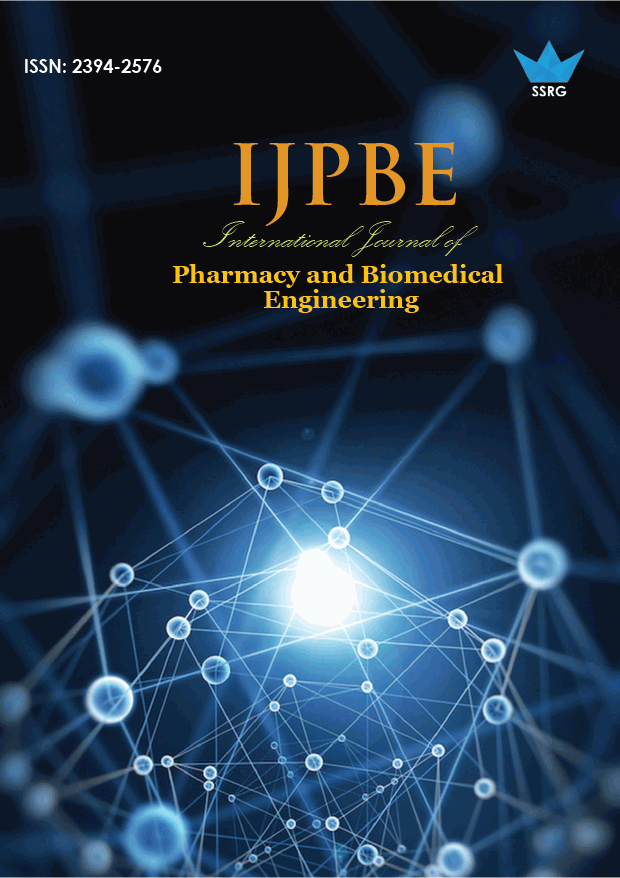Solid and Poroelastic Models of Intraluminal Thrombus Using Finite Element Method

| International Journal of Pharmacy and Biomedical Engineering |
| © 2024 by SSRG - IJPBE Journal |
| Volume 11 Issue 1 |
| Year of Publication : 2024 |
| Authors : Omar Altwijri |
How to Cite?
Omar Altwijri, "Solid and Poroelastic Models of Intraluminal Thrombus Using Finite Element Method," SSRG International Journal of Pharmacy and Biomedical Engineering, vol. 11, no. 1, pp. 1-5, 2024. Crossref, https://doi.org/10.14445/23942576/IJPBE-V11I1P101
Abstract:
The porosity of intraluminal thrombus will be examined in this study, and the results will be compared to those of solid intraluminal thrombus. Two three-dimensional models were used in this investigation. The first used poroelastic material, and the second used solid material. The findings of the present study revealed that the difference in wall stresses gained from the three situations is negligible (about 2.2%) based on the two models examined. The distribution of wall stress and the position of greatest stress remain unchanged. In summary, if maximal wall stresses are needed, the porosity of intraluminal thrombus may be ignored because there is little effect of using porous media for intraluminal thrombus on the maximum value and distribution of wall stresses.
Keywords:
Abdominal aortic aneurysm, Aortic rupture, Finite element analysis, Intraluminal thrombus model.
References:
[1] John H. Ashton et al., “Compressive Mechanical Properties of the Intraluminal Thrombus in Abdominal Aortic Aneurysms and Fibrin-Based Thrombus Mimics,” Journal of Biomechanics, vol. 42, no. 3, pp. 197-201, 2009.
[CrossRef] [Google Scholar] [Publisher Link]
[2] Avinash Ayyalasomayajula, Jonathan P. Vande Geest, and Bruce R. Simon, “Porohyperelastic Finite Element Modeling of abdominal Aortic Aneurysms,” Journal of Biomechanical Engineering, vol. 132, no. 10, pp. 1-8, 2010.
[CrossRef] [Google Scholar] [Publisher Link]
[3] S. Polzer, and J. Bursa, “Poroelastic Model of Intraluminal Thrombus in FEA of Aortic Aneurysm,” 6 th World Congress of Biomechanics (WCB 2010), Singapore, pp. 763-767, 2010.
[CrossRef] [Google Scholar] [Publisher Link]
[4] Sofia Loffredo, Carine Guivier-Curien, and Valerie Deplano, “Influence of the Presence of a Porous Thrombus on Hemodynamics in a CFD Model of a Descending Thoracic Aneurysm,” Biomechanics Society Congress, pp. 189-191, 2021.
[Google Scholar] [Publisher Link]
[5] Clark A. Meyer, Carine Guivier-Curien, and James E. Moore, “Trans-Thrombus Blood Pressure Effects in Abdominal Aortic Aneurysms,” Journal of Biomechanical Engineering, vol. 132, no. 7, pp. 1-7, 2010.
[CrossRef] [Google Scholar] [Publisher Link]
[6] Tanja Cupae, “Multiphysics Computational Model of Fluid Flow and Mass Transport in Aneurysm,” Duquesne University Pro Quest Dissertations Publishing, pp. 1-13, 2020.
[Google Scholar] [Publisher Link]
[7] Suresh Kumar Govindarajan, “An Overview on Extension and Limitations of Macroscopic Darcy’s Law for a Single and Multi-Phase Fluid Flow Through a Porous Medium,” International Journal of Mining Science, vol. 5, no. 4, pp. 1-21, 2019.
[CrossRef] [Google Scholar] [Publisher Link]
[8] Randall Adolph et al., “Cellular Content and Permeability of Intraluminal Thrombus in Abdominal Aortic Aneurysm,” Journal of Vascular Surgery, vol. 25, no. 5, pp. 916-926, 1997.
[CrossRef] [Google Scholar] [Publisher Link]
[9] H.E. Salman, and H.C. Yalcin, “Computational Investigation of the Effect of Wall Thickness on Rupture Risk in Abdominal Aortic Aneurysms,” Journal of Applied Fluid Mechanics, vol. 14, no. 2, pp. 499-513, 2021.
[CrossRef] [Google Scholar] [Publisher Link]
[10] A. Maier et al., “A Comparison of Diameter, Wall Stress, and Rupture Potential Index for Abdominal Aortic Aneurysm Rupture Risk Prediction,” Annals of Biomedical Engineering, vol. 38, pp. 3124- 3134, 2010.
[CrossRef] [Google Scholar] [Publisher Link]

 10.14445/23942576/IJPBE-V11I1P101
10.14445/23942576/IJPBE-V11I1P101